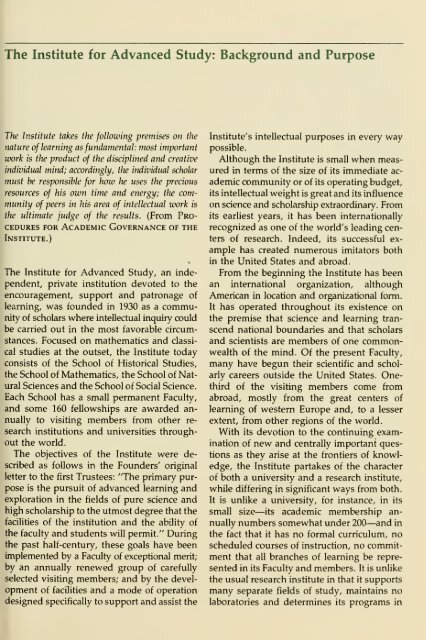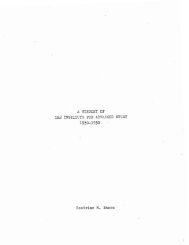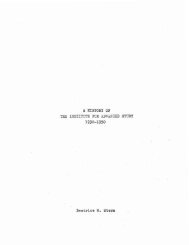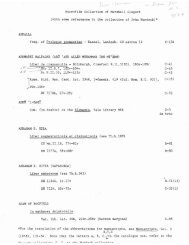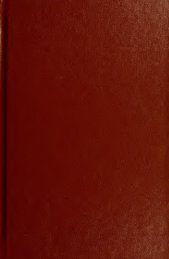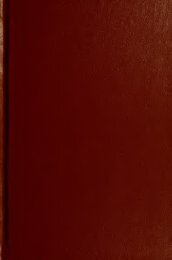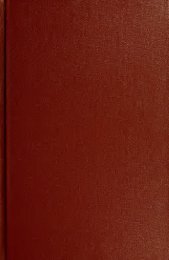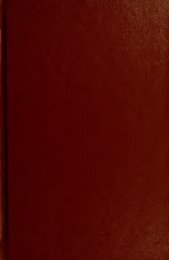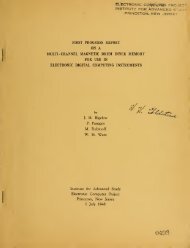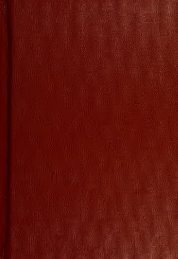Annual Report for the Fiscal Year July 1, 1980- June 30, 1981
Annual Report for the Fiscal Year July 1, 1980- June 30, 1981
Annual Report for the Fiscal Year July 1, 1980- June 30, 1981
You also want an ePaper? Increase the reach of your titles
YUMPU automatically turns print PDFs into web optimized ePapers that Google loves.
The Institute <strong>for</strong> Advanced Study: Background and Purpose<br />
The Institute takes <strong>the</strong> following premises on <strong>the</strong><br />
nature of learning as fundamental: most important<br />
work is <strong>the</strong> product of <strong>the</strong> disciplined and creative<br />
individual mind; accordingly, <strong>the</strong> individual scholar<br />
must be responsible <strong>for</strong> how he uses <strong>the</strong> precious<br />
resources of his own time and energy; <strong>the</strong> com-<br />
munity of peers in his area of intellectual work is<br />
<strong>the</strong> ultimate judge of <strong>the</strong> results. (From Procedures<br />
FOR Academic Governance of <strong>the</strong><br />
Institute.)<br />
The Institute <strong>for</strong> Advanced Study, an independent,<br />
private institution devoted to <strong>the</strong><br />
encouragement, support and patronage of<br />
learning, was founded in 19<strong>30</strong> as a community<br />
of scholars where intellectual inquiry could<br />
be carried out in <strong>the</strong> most favorable circum-<br />
stances. Focused on ma<strong>the</strong>matics and classi-<br />
cal studies at <strong>the</strong> outset, <strong>the</strong> Institute today<br />
consists of <strong>the</strong> School of Historical Studies,<br />
<strong>the</strong> School of Ma<strong>the</strong>matics, <strong>the</strong> School of Nat-<br />
ural Sciences and <strong>the</strong> School of Social Science.<br />
Each School has a small permanent Faculty,<br />
and some 160 fellowships are awarded an-<br />
nually to visiting members from o<strong>the</strong>r re-<br />
search institutions and universities through-<br />
out <strong>the</strong> world.<br />
The objectives of <strong>the</strong> Institute were de-<br />
scribed as follows in <strong>the</strong> Founders' original<br />
letter to <strong>the</strong> first Trustees: "The primary purpose<br />
is <strong>the</strong> pursuit of advanced learning and<br />
exploration in <strong>the</strong> fields of pure science and<br />
high scholarship to <strong>the</strong> utmost degree that <strong>the</strong><br />
facilities of <strong>the</strong> institution and <strong>the</strong> ability of<br />
<strong>the</strong> faculty and students will permit." During<br />
<strong>the</strong> past half-century, <strong>the</strong>se goals have been<br />
implemented by a Faculty of exceptional merit;<br />
by an annually renewed group of carefully<br />
selected visiting members; and by <strong>the</strong> development<br />
of facilities and a mode of operation<br />
designed specifically to support and assist <strong>the</strong><br />
Institute's intellectual purposes in every way<br />
possible.<br />
Although <strong>the</strong> Institute is small when measured<br />
in terms of <strong>the</strong> size of its immediate academic<br />
community or of its operating budget,<br />
its intellectual weight is great and its influence<br />
on science and scholarship extraordinary. From<br />
its earliest years, it has been internationally<br />
recognized as one of <strong>the</strong> world's leading cen-<br />
ters of research. Indeed, its successful example<br />
has created numerous imitators both<br />
in <strong>the</strong> United States and abroad.<br />
From <strong>the</strong> beginning <strong>the</strong> Institute has been<br />
an international organization, although<br />
American in location and organizational <strong>for</strong>m.<br />
It has operated throughout its existence on<br />
<strong>the</strong> premise that science and learning transcend<br />
national boundaries and that scholars<br />
and scientists are members of one commonwealth<br />
of <strong>the</strong> mind. Of <strong>the</strong> present Faculty,<br />
many have begun <strong>the</strong>ir scientific and scholarly<br />
careers outside <strong>the</strong> United States. Onethird<br />
of <strong>the</strong> visiting members come from<br />
abroad, mostly from <strong>the</strong> great centers of<br />
learning of western Europe and, to a lesser<br />
extent, from o<strong>the</strong>r regions of <strong>the</strong> world.<br />
With its devotion to <strong>the</strong> continuing exam-<br />
ination of new and centrally important questions<br />
as <strong>the</strong>y arise at <strong>the</strong> frontiers of knowl-<br />
edge, <strong>the</strong> Institute partakes of <strong>the</strong> character<br />
of both a university and a research institute,<br />
while differing in significant ways from both.<br />
It is unlike a university, <strong>for</strong> instance, in its<br />
small size—its academic membership an-<br />
nually numbers somewhat under 200—and in<br />
<strong>the</strong> fact that it has no <strong>for</strong>mal curriculum, no<br />
scheduled courses of instruction, no commitment<br />
that all branches of learning be represented<br />
in its Faculty and members. It is unlike<br />
<strong>the</strong> usual research institute in that it supports<br />
many separate fields of study, maintains no<br />
laboratories and determines its programs in


